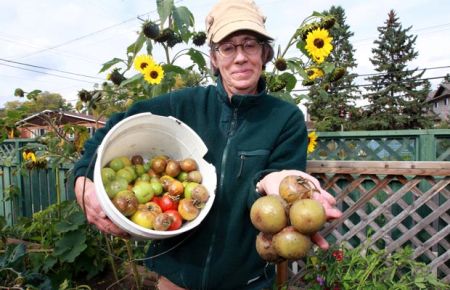
The airborne disease called late blight of potato -- the same organism that led to the Irish potato famine -- is rare in Alberta, said forensic plant pathologist Ieuan Evans. However, a "giant outbreak" of the potato disease is attacking tomato plants this season and causing hundreds of thousands of dollars in damage, Evans said Sunday.
"We've never had this strain in Alberta before -- it's a tomato strain of late blight and it's extremely virulent in tomatoes," he said. "On the prairies, the last time we had an outbreak of late blight of any consequence was 1993, when it went right through Edmonton, but that was a potato strain."
Gardener Katherine Shute spent Sunday afternoon clearing out the withered remains of her diseased fruit. She spent the summer caring for 36 tomato plants in the large garden behind her Riverdale home and they have all rotted.
"It's so heartbreaking," she said. "I always grow a lot of tomatoes. I either make spaghetti sauce, salsa or tomato sauce and freeze them or can them so they last me well into spring, and it's just really discouraging."
Shute first spotted brown blotches on her tomatoes in July. She thought the spots were caused by hail until a friend warned her about late blight and neighbours told her the disease is attacking Edmonton gardens this year.
"Other than the tomatoes we ate initially, 90 per cent of our crop is gone, which is tough. We grow our own food and we love our tomatoes.
"In the fall, I keep large bowls of tomatoes in the kitchen and the living room and we eat them instead of candy because they're so wonderful," she said.
"The question is, where did it come from?"
The disease popped up this summer in a garden at the St. Albert Botanic Park, said park president Margaret Plain.
Experts, including Evans, diagnosed the disease there about two weeks ago, prompting garden volunteers to immediately start clearing out the plants, taking care to dispose of them so the fungus can't spread, Plain said.
"What you want to do is get rid of those diseased plants in a safe way because the spores can travel. You want to put the foliage of the plants in a plastic bag and tie it up shut and find a place that will take diseased vegetation."
Warnings about late blight are posted on the city of St. Albert website, the Edmonton Horticultural Society website and the St. Albert and District Garden Club website.
"We wanted to get the information out while people are wondering what to do and so people can dispose of them properly," said Derrick Harrison, president of the St. Albert and District Garden Club.
There are a couple of theories about how the blight started, said Evans.
Testing has shown some tomato seedling plants sold in Edmonton big-box stores were contaminated with the fungus, Evans said.
Those plants were likely imported from warm and wet outdoor growing areas, such as those in B.C., where late-blight spores can easily spread, he said.
It's also possible the disease built up in potatoes grown around the Edmonton region before it spread to tomato plants, said Evans.
By mid-August, Evans had reports of the disease on tomatoes in Mill Woods, then in Spruce Grove. Thunderstorms quickly spread the spores farther.
"It spread the tomato blight all around Edmonton and surprisingly it spread it all the way up to Smoky Lake, even. There were clouds of this fungus and it blanketed the whole of central Alberta," said Evans.
"Probably hundreds of thousands of dollars worth of homegrown tomatoes right across the prairies have been wiped out, including those at Hutterite colonies. They grow lots of tomatoes and it got in and wiped out their crops."
The disease is also attacking tomatoes in Saskatchewan and Manitoba, he said.
The fungus can affect other plants in the potato family such as tobacco, peppers, eggplant and petunias, said Evans.
It could stick around Alberta through the winter on potatoes that are stored and not checked, warned Evans.
It could also be brought in again next year on potatoes or tomato plants grown outdoors in places such as B.C. or the United States that don't freeze over the winter.
However, greenhouse-grown tomatoes and Alberta-grown tomatoes and seedlings will be free of the disease next season, said Evans.
"The fungus won't survive on tomato debris, leaves and stems. It will die off over winter," he said.
"It does not survive (winter) in Alberta on anything except stored potatoes, so be very careful with your stored potatoes.
"Anyone showing any lesion or injury, cut the lesion out and eat the darn thing."



The official story of what happened in Ireland in the mid 19th century & what is still taught in schools today is a cover-up.
[Link]